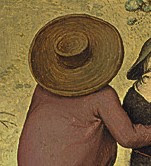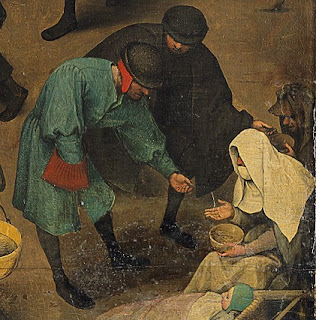The Renaissance Faire is a peculiar event that sprouted from a high school history project in Southern California during the early 1960’s. It has grown into a sub-culture that spans across the United States, Canada and Europe. Some events are solid historically based events, others are hysterical spectacles of flesh and fantasy, clinging to a thread of Renaissance history…

The Peasantry...sweaty, stinky...prone to laziness, drunkenness and immoral fornication...who wouldn't want to hang out with this bunch? Almost as good as being kidnapped by pirates…
What was a peasant? Well the short answer would be agricultural and working poor....dirt farmers, laborers, dubious sellers of exotic, sexual elixirs in the back alley. Throughout history, it was not necessarily a bad thing to be a peasant. Most of Europe, Russia, Asia and Africa's population fell into this category. Farming and labor (at least in the rural areas) was seasonal. You put it long hard days during the growing season, but by Autumn you were done, and the Winter was all yours to eat, drink, party, play and sleep. While not a life of ease, it was not exactly the grueling 8-5 job of an Amazon "worker bee".
The purpose of this article is not to go into great historical depth regarding Europe's peasant class during this period. The focus is about what you would look like, should you wish to portray a peasant at a Renaissance Faire and how you can legitimately incorporate earlier Medieval garb into you look, while still being reasonably accurate. Some Faire "historians" will throw shade on peasant reenactors in earlier period garb...I'm going to show you, with period artwork, that it is right and historically correct...so you can tell that individual to "go do some more research before they open up their big mouth".
The first thing I noticed when looking at period visual resources, a fancy phrase for paintings of the era, was the stark similarities in peasant dress from the Medieval period to the end of the 1500's. Aside from a few English woodcuts and drawings that show farmers in more up to date clothing, i.e. late renaissance clothing such as doublets, breeches/venetians, slops, and garters, most of the paintings show a people that are 100 years or more behind on the fashion curve. You have split hose, long doublets, pointy turn shoes, codpieces, cowls and hoods, all indictive of the Middle Ages. These clothes are at least 50 years past the expiration date....however, evidence for their use during the Renaissance is there, in living color. One could sum this up as "having what you had", and local manufacture. The latest fashions from Madrid, Paris and London are not going to make it all that far past the city walls. Local clothing was probably made by a wife for her husband and sons. This is what she knew and is what Mother taught her to make, so you wouldn't see the latest and greatest styles on a lowly commoner.
You'll also notice that peasants of the period are not in rags and are not mangey beggars...that's a topic for another day...and a completely different category of poor...peasant's clothing is worn in many of the artistic impressions, but not on its "last legs".
Let's dive into some of the contemporary sources...
The garb of the peasant in the Renaissance is very regional. England tended to have a peasantry that dressed in more up-to-date clothing. This could very well have to do with charitable organizations that created, acquired and freely distributed clothing to the poor and lower-class. The Tooley Foundation in Ipswich England is a perfect example. Henry Tooley, the richest man in Ipswich town, bequeathed all of his holdings (and it was extensive) to creating a foundation for the poor upon his demise in 1561. Years of legal battles on "who was entitled to get what" eventually ended with an operation that created the roadmap on how to take care of your town's poor and indigent, operating non-stop since the late 16th-century. It is my guess that beggars and street urchins weren't the only benefactors of the Tooley Foundation. I'm sure many peasants benefited and were recipients of the wide variety of new clothing distributed by the Tooley Foundation. From hats to shoes, and everything in between, it clothed the local lower-classes and was more than likely one of many examples of Elizabethan Era charities.
Some examples the cloth used in these clothes are:
Wool - cheap homespun (grey or brown most likely), kersey, frieze (heavy weight), cotton (for lining...it's the wool known as "cotton"...not cotton itself)
Linen - for clothing and lining as well as a lighter weight known as "lockram" for shirts
Canvas - Made from hemp and used to make everything from petticoats to waistcoats to shirts as well
Moving into Europe, we see a very different look in peasant clothing...along the lines of the Venetian coal porters, the clothing more Medieval in shape, style and fit. This is not to say that the British Isles didn't have peasants who garbed themselves in this fashion and I won't discourage the lower class medieval look for an English themed Renaissance event...I simply have not seen much evidence for its widespread use in England.

Perhaps the bogtrotters across the Irish Sea...on that...island, or the skirt-wearing slobs to the North had peasants that dressed more frequently in grandmother's threads...
Here is a contemporary example from the early 15th-century, exhibiting late Medieval peasant garb...
Medieval caped hood.

Bag purse...

A thin Medieval type belt and a very Medieval looking girdle purse.
Notice the very thin belt and Medieval style pouch purse. In the next detail, we see a very Medieval style shirt with a "boat-neck"...

Another very Medieval-type hood, 1559...

And another from a different work of art...mid-16th-century

Pilgrim badges...
What appears to be a middle or upper class gentleman. The look is so Middle Ages/Medieval that it seems out of place...but this is a painting that was created in the second year of Elizabeth's reign, squarely in the Renaissance...



All these purses are being used by what can be considered the the lower classes/peasants, and I find it interesting that peasants are carrying framed ring purses...

Straw hat...not exclusively Medieval, but very similar to straw hats of the period.

This appears to be an "acorn" hat...a fashion squarely in the late-Medieval period...but again, apparently worn into the early Renaissance.
Lastly, there is nothing "Renaissance" about this part of the painting...these nobles are all wearing mid to late Medieval garb...and no one told them it's 1559. I'm not really sure this was an accurate portrayal by Bruegel, but why would he paint the nobility in clothing from roughly 100 years previous? It is odd... If you want to wear a "chatelaine" to a Renaissance event...there is evidence of this hat's late existence in at least three of Bruegel's works.
Here are a selection of Bruegel paintings that exhibit a wide selection of regional peasant clothing for the Netherlands...with many examples of dress from an earlier period continuing into the Renaissance...
Here is a German example from 1598 by Lucas van Valckenborch. Notice that Medeival-type clothing is starting to disappear and more modern fashions are taking hold in the peasant dress.
Peasant dress in the Netherlands c.1590s by Jan Bruegel the Elder. Notice the hose...virtually unchanged from the Middle Ages.
All sources presented here point to the existence of much, much older fashion styles being worn by peasants throughout Europe. These clothes remained in use at least until the mid 17th-century. My evidence? The very first painting at the top dates to 1635...and the peasants represented are almost indistinguishable in appearance to the "salt of the earth" that drunkenly caroused in the 1450s...


An escoffin,1558...looks like 1458...but no...it's the Ren...





































